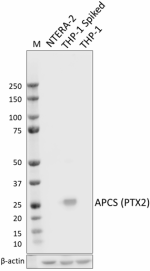- Clone
- W19147A (See other available formats)
- Regulatory Status
- RUO
- Isotype
- Rat IgG2a, κ
- Ave. Rating
- Submit a Review
- Product Citations
- publications

-

IHC staining of purified anti-APCS (PTX2) (clone W19147A) on formalin-fixed paraffin-embedded human testis tissue. Following antigen retrieval using Tris-EDTA, pH 9.0, the tissue was incubated without (panel A) and with (panel B) 5.0 µg/mL of primary antibody followed by incubation with Alexa Fluor® 647 goat anti-rat IgG (magenta) (Cat. No. 405416) for 1 hour at room temperature. Nuclei were counterstained with DAPI (blue) (Cat. No. 422801). Images were captured with a 10X objective. Scale bar: 50 µm -

Whole cell extracts (15 µg total protein) from NTERA-2 cells, THP-1 cells spiked with recombinant human APCS protein (Cat. No. 556606), and THP-1 cells were resolved by 4-12% Bis-Tris gel electrophoresis, transferred to a PVDF membrane, and probed with 1.0 µg/mL of purified anti-APCS (PTX2) (clone W19147A) overnight at 4°C. Proteins were visualized by chemiluminescence detection using HRP goat anti-rat IgG (Cat. No. 405405). Direct-Blot™ HRP anti-β-actin (Cat. No. 643807) was used as a loading control at a 1:10000 dilution. Western-Ready™ ECL Substrate Premium Kit (Cat. No. 426319) was used as a detection agent. Lane M: Molecular weight marker
| Cat # | Size | Price | Quantity Check Availability | Save | ||
|---|---|---|---|---|---|---|
| 614651 | 25 µg | £83 | ||||
| 614652 | 100 µg | £271 | ||||
APCS (amyloid P component, serum), also known as pentraxin 2 (PTX2), is a member of the pentraxin family, which has a non-covalently linked pentameric organization. This protein is characterized by its calcium-dependent ligand binding and distinctive flattened β-jellyroll structure similar to legume lectins. Human APCS shares a 79% amino acid homology with its mouse counterpart. APCS is secreted by hepatocytes as part of the acute phase protein synthesis in response to infections. Upon binding to its ligands, APCS is involved in the activation of classical complement cascade. In a mouse model, APCS was shown to downregulate acute inflammation accompanying experimental autoimmune encephalomyelitis by regulating T cell activity. In addition to its role in regulating immune response, APCS is found to be a component of amyloid deposits which have the ability of stabilizing amyloid fibrils and protecting them from proteolytic degradation. It is postulated that APCS may play a role in Alzheimer's disease and other amyloidosis. Interestingly, APCS is also identified as a component of basement membrane proteins and is able to bind laminin, collagen IV, P-selectin, and fibronectin in a Ca2+ dependent manner. In addition, APCS is known to specifically localize in human atherosclerotic lesions, which suggests that it may play a role in atherogenesis. Functional studies revealed that APCS binds to lipoproteins, specifically to HDL, but not LDL.
Product DetailsProduct Details
- Verified Reactivity
- Human
- Antibody Type
- Monoclonal
- Host Species
- Rat
- Immunogen
- Recombinant fragment of human APCS
- Formulation
- Phosphate-buffered solution, pH 7.2, containing 0.09% sodium azide
- Preparation
- The antibody was purified by affinity chromatography.
- Concentration
- 0.5 mg/mL
- Storage & Handling
- The antibody solution should be stored undiluted between 2°C and 8°C.
- Application
-
IHC-P - Quality tested
WB - Verified - Recommended Usage
-
Each lot of this antibody is quality control tested by formalin-fixed paraffin-embedded immunohistochemical staining. For immunohistochemistry on formalin-fixed paraffin-embedded tissue sections, a concentration range of 1.0 - 10.0 µg/mL is suggested. For western blotting, the suggested use of this reagent is 0.1 - 1.0 µg/mL. It is recommended that the reagent be titrated for optimal performance for each application.
- RRID
-
AB_2941618 (BioLegend Cat. No. 614651)
AB_2941618 (BioLegend Cat. No. 614652)
Antigen Details
- Structure
- Monomer
- Distribution
-
Liver, serum and urine
- Function
- APCS recognizes microbial pathogens and activates the classical complement pathway; it binds to Fcγ receptors and opsonizes particles for phagocytosis
- Interaction
- Cells expressing Fcγ receptors
- Ligand/Receptor
- FcγR (CD16, CD32, and CD64), collagen IV, laminin, HDL, VLDL, fibronectin, CRP, and CD62L
- Biology Area
- Complement, Neurodegeneration, Neuroinflammation
- Molecular Family
- APP/β-Amyloid, APP/Aβ Degradation
- Antigen References
-
- Tennent GA, et al. 1995. Proc Natl Acad Sci USA. 92:4299-303.
- Li XA, et al. 1998. Biochem Biophys Res Commun. 244:249-52.
- Zahedi K. 1996. J Biol Chem. 271:14897-902.
- Pepys M, et al. 2002. Nature. 417:254-9.
- Stibenz D, et al. 2006. Eur J Immunol. 36:446-56.
- Lu J, et al. 2008. Nature. 456:989-92.
- Gene ID
- 325 View all products for this Gene ID
- UniProt
- View information about APCS on UniProt.org
Related FAQs
Other Formats
View All APCS Reagents Request Custom Conjugation| Description | Clone | Applications |
|---|---|---|
| Purified anti-APCS (PTX2) | W19147A | IHC-P,WB |
Compare Data Across All Formats
This data display is provided for general comparisons between formats.
Your actual data may vary due to variations in samples, target cells, instruments and their settings, staining conditions, and other factors.
If you need assistance with selecting the best format contact our expert technical support team.
 Login / Register
Login / Register 









Follow Us